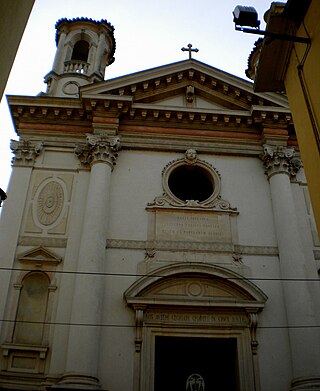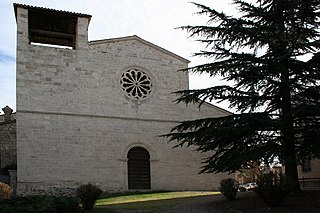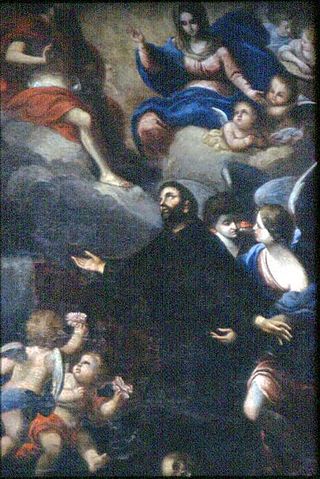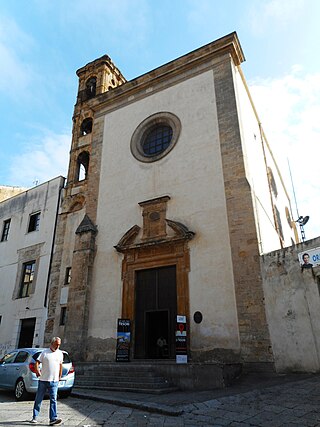
San Giorgio is a Roman Catholic church located on the Piazza of the same name, just outside Porta Bruciata, in Brescia, region of Lombardy, Italy. Coordinates: 45°32′28″N10°13′16″E / 45.5410363°N 10.2212492°E

San Giorgio is a Roman Catholic church located on the Piazza of the same name, just outside Porta Bruciata, in Brescia, region of Lombardy, Italy. Coordinates: 45°32′28″N10°13′16″E / 45.5410363°N 10.2212492°E
A church at the site is documented since 775. In 1218, Franciscan friars erected a nearby monastery and were in possession of the church. But by 1254, they had moved to the convent and church of San Francesco. By 1429, this parish church was in a dilapidated state, and a major restoration, including present facade occurred in 1639. [1]
An inventory of works in 1826 noted to right of nave an oil painting depicting a Nativity, by Giovita Bresciano, a pupil of Lattanzio Gambara. The main altarpiece depicted was by a young Gandini and two side-panels depicting St George and the Dragon and a Martyrdom of St George by Pompeo Ghitti. [2]
In addition, in the chapels on the left of the nave, there was a Virgin with Saints Francis of Paola and Leonard, by Giovanni Battista Pittoni. [3] A canvas depicting Virgin with Francis of Sales and St Catherine was attributed to Domenico Carretti. A Sacred Heart of Jesus was attributed to Antonio Dusi. A Dead Christ with St Charles is attributed to Savani. In the sacristy are some frescoes from the original romanesque church. [4] Saint George and the Princess by Cicognara also originated in the church.
The church also contains 13th century frescoes including a Christ Pantocrater. The nave ceiling was decorated by Pietro Sorisene and Pompeo Ghitti with architectural decoration by Agostino Avanzo. The apse ceiling has a depiction of the Seven Angels of the Apocalypse by Ottavio Amigoni. The exterior of the apse still betrays the Romanesque architecture of the original church.

The Church of the Gesù is the mother church of the Society of Jesus (Jesuits), a Catholic religious order. Officially named Chiesa del Santissimo Nome di Gesù all'Argentina, its facade is "the first truly baroque façade", introducing the baroque style into architecture. The church served as a model for innumerable Jesuit churches all over the world, especially in the Americas. Its paintings in the nave, crossing, and side chapels became models for Jesuit churches throughout Italy and Europe, as well as those of other orders. The Church of the Gesù is located in the Piazza del Gesù in Rome.

The Basilica of Saint Francis of Assisi is the mother church of the Roman Catholic Order of Friars Minor Conventual in Assisi, a town in the Umbria region in central Italy, where Saint Francis was born and died. It is a Papal minor basilica and one of the most important places of Christian pilgrimage in Italy. With its accompanying friary, Sacro Convento, the basilica is a distinctive landmark to those approaching Assisi. It has been a UNESCO World Heritage Site since 2000.

Assisi Cathedral, dedicated to San Rufino is a major church in Assisi, Italy. This stately church in Umbrian Romanesque style was the third church built on the same site to contain the remains of bishop Rufinus of Assisi, martyred in the 3rd century. The construction was started in 1140 to the designs by Giovanni da Gubbio, as attested by the wall inscription visible inside the apse. He may be the same Giovanni who designed the rose-window on the façade of Santa Maria Maggiore in 1163.

The Tempio della Beata Vergine della Ghiara, also known as Basilica della Madonna della Ghiara, is a church in Reggio Emilia, northern Italy. The building is the property of the comune (municipality) of the city.

Pompeo Ghitti was an Italian painter of the Baroque period, active mainly in and in towns surrounding Brescia.

Pistoia Cathedral, or Cathedral of Saint Zeno is the main religious building of Pistoia, Tuscany, central Italy, located in the Piazza del Duomo in the centre of the city. It is the seat of the Bishop of Pistoia and is dedicated to Saint Zeno of Verona.

The church of Sant'Afra in Brescia, also known as the church of Sant'Afra in Sant'Eufemia, is located on Corso Magenta, near Piazzale Arnaldo.

Brarup Church is located in the village of Brarup some 5 km (3.1 mi) southwest of Nørre Alslev on the Danish island of Falster. The Late Romanesque church has frescos from various periods including several by the Brarup Master and his workshop from the early 16th century.

The Basilica of San Fedele in Como is located in the city center and is dedicated to Saint Fidelis martyr. It derives from an earlier Christian church, dating from the seventh century, dedicated to Euphemia.

Santi Primo e Feliciano is a Romanesque-style Roman Catholic church in the town center of Pavia, Italy.

Santa Croce is a Roman Catholic church located on Corso Vittorio Emanuele 178 in Padua, Veneto region, Italy.

San Francesco is a Romanesque-Gothic style, Roman Catholic church and Franciscan monastery located on Via San Francesco d'Assisi in central Brescia, region of Lombardy, Italy.

San Pietro in Oliveto is a Roman Catholic church located at the end of via del Castello in central Brescia, region of Lombardy, Italy.

San Francesco is a Romanesque and Gothic-style, Roman Catholic church located at Piazza San Francesco in Pescia, region of Tuscany, Italy.

The Church of Saint Mary of Pity is a Baroque church of Palermo. It is located at the corner of Via Alloro and Via Torremuzza in the quarter of the Kalsa, within the historic centre of Palermo.

San Vittore is a Romanesque and Gothic-style, Roman Catholic church located in the town of Ascoli Piceno in the region of Marche, Italy.

San Barnaba is a deconsecrated Baroque-style, Roman Catholic church, located on Corso Magenta #44, near Piazzale Arnaldo, in Brescia, region of Lombardy, Italy. The church in the 20th century became an auditorium and conference hall, and home of the Conservatorio Luca Marenzio.
San Girolamo is a 15th-century Roman Catholic church located in Spello, province of Perugia, region of Umbria, Italy.

Andrea Carrera or Carreca was an Italian Baroque painter mainly active in Sicily. He was born in Trapani and died in Palermo.

Santa Chiara all'Albergaria refers to a church and former monastery located in piazza Santa Chiara, in the quarter of Albergaria in the city of Palermo, region of Sicily, Italy. The church is located near the busy outdoor Ballarò marketplace.